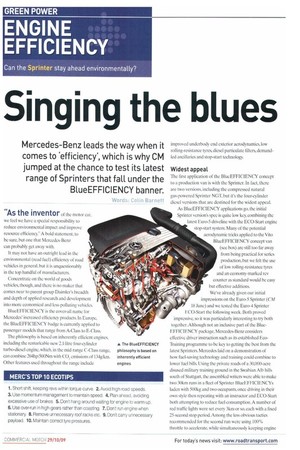Singing the blues
Page 46

Page 47

If you've noticed an error in this article please click here to report it so we can fix it.
Mercedes-Benz leads the way when it comes to 'efficiency', which is why CM jumped at the chance to test its latest range of Sprinters that fall under the BlueEFFICIENCY banner.
Words: Colin Barnett "As the inventor of the motor car, we feel we have a special responsibility to reduce environmental impact and improve resource efficiency." A bold statement, to be sure, but one that Mercedes-Benz can probably get away with.
It may not have an outright lead in the environmental (read fuel) efficiency of road vehicles in general, but it is unquestionably in the top handful of manufacturers.
Concentrate on the world of goods vehicles, though, and there is no maker that comes near to parent group Daimler's breadth and depth of applied research and development into more economical and less-polluting vehicles.
Blue EFFICIENCY is the cover-all name for Mercedes' increased efficiency products. In Europe, the BlueEFFICIENCY badge is currently applied to passenger models that range from A-Class to E-Class.
The philosophy is based on inherently efficient engines,
including the remarkable new 2.1-litre four-cylinder A The BlueEFFICIENCY turbo-diesel engine, which, in the mid-range C-Class range, philosophy is based on can combine 204hp/500Nm with CO, emissions of 134g/km. inherently efficient Other features used throughout the range include engines
improved underbody end exterior aerodynamics, low rolling-resistance tyres, diesel particulate filters, demandled ancillaries and stop-start technology
Widest appeal
The first application of the BlueEFFICIENCY concept to a production van is with the Sprinter. In fact, there are two versions, including the compressed natural gas-powered Sprinter NGT, but it's the four-cylinder diesel versions that are destined for the widest appeal. As BlueEFFICIENCY applications go, the initial Sprinter version's spec is quite low key, combining the latest Euro-5 driveline with the ECO-Start engine stop-start system. Many of the potential aerodynamic tricks applied to the Vito BlueEFFICIENCY concept van (see box) are still too far away from being practical for series production, but we felt the use of low rolling-resistance tyres and an economy-marked rev counter as standard would be easy but effective additions.
We've already given our initial impressions on the Eum-5 Sprinter (CM 18 June) and we tested the Euro-4 Sprinter ECO-Start the following week. Both proved impressive, so it was particularly interesting to try both together. Although not an inclusive part of the BlueEFFICIENCY package, Mercedes-Benz considers effective driver instruction such as its established EcoTraining programme to be key to getting the best from the latest Sprinters. Mercedes laid on a demonstration of how fuel-saving technology and training could combine to lower fuel bills. Using the private roads of a 30,000-acre disused military training ground in the Swabian Alb hills south of Stuttgart. the assembled writers were able to make two 30km runs in a fleet of Sprinter BlueEFFICIENCYs laden with 500kg and two occupants, once driving in their own style then repeating with an instructor and ECO-Start both attempting to reduce fuel consumption.A number of red traffic lights were set every 3km or so. each with a fixed 25-second stop period. Among the less obvious tactics recommended for the second rim were using 100% throttle to accelerate, while simultaneously keeping engine speed within the optimum range.
Given that the test subjects varied considerably in economy driving expertise, the improvements gained were also wide ranging. Two drivers managed to achieve exactly the same consumption on both runs, although their average speeds were 14.3 and 4.8% faster on the second run. The best fuel improvement was 18.3%, combined with a 2.3% faster time, while across the board, fuel and time saved were 6.7% and 7.0% respectively. Interestingly, the biggest fuel savings with training and Eco-Training were seen on the lowest powered 310CDI model (8.6%), compared with the 313CDI (6.1%) and 316CD (5.2%).
Overall honours
Average economy by model saw the two lower-powered models both average 31.7mpg, with the 316CD Is averaging 30.1mpg. CM's performance of 30.7inpg was the best in a 316CDI, but overall honours went to a Danish-driven 313CDI with an impressive 35.3mpg.
Lessons learned from the exercise were that even in tough terrain, the best vans can give excellent economy and that training definitely does pay.
How you motivate and reward van drivers when the potential savings are considerably smaller than for a heavy truck using 10 times as much fuel each day was the subject of much discussion, and remained an unresolved issue for another day.








































































































































